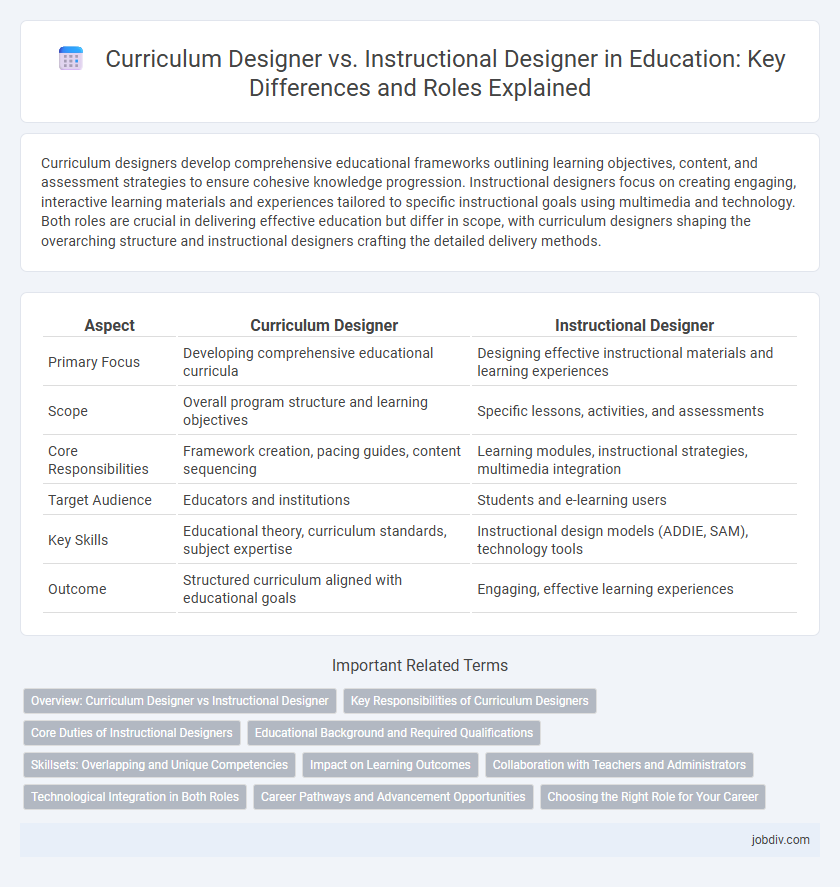Curriculum designers develop comprehensive educational frameworks outlining learning objectives, content, and assessment strategies to ensure cohesive knowledge progression. Instructional designers focus on creating engaging, interactive learning materials and experiences tailored to specific instructional goals using multimedia and technology. Both roles are crucial in delivering effective education but differ in scope, with curriculum designers shaping the overarching structure and instructional designers crafting the detailed delivery methods.
Table of Comparison
| Aspect | Curriculum Designer | Instructional Designer |
|---|---|---|
| Primary Focus | Developing comprehensive educational curricula | Designing effective instructional materials and learning experiences |
| Scope | Overall program structure and learning objectives | Specific lessons, activities, and assessments |
| Core Responsibilities | Framework creation, pacing guides, content sequencing | Learning modules, instructional strategies, multimedia integration |
| Target Audience | Educators and institutions | Students and e-learning users |
| Key Skills | Educational theory, curriculum standards, subject expertise | Instructional design models (ADDIE, SAM), technology tools |
| Outcome | Structured curriculum aligned with educational goals | Engaging, effective learning experiences |
Overview: Curriculum Designer vs Instructional Designer
Curriculum designers develop comprehensive educational frameworks that outline learning objectives, content scope, and assessment strategies across entire programs, ensuring alignment with academic standards and institutional goals. Instructional designers create detailed learning materials and activities within these frameworks, focusing on effective delivery methods, technology integration, and learner engagement to optimize knowledge acquisition. Both roles collaborate closely, but curriculum designers emphasize macro-level planning while instructional designers concentrate on micro-level execution.
Key Responsibilities of Curriculum Designers
Curriculum designers develop comprehensive educational frameworks, aligning learning objectives, content sequencing, and assessment strategies to meet academic standards and learner needs. They collaborate with subject matter experts and educators to create cohesive curricula that support student skill development and knowledge retention. Their responsibilities include analyzing educational requirements, designing course structures, and evaluating curriculum effectiveness to ensure continuous improvement.
Core Duties of Instructional Designers
Instructional designers primarily develop engaging educational materials by applying learning theories and instructional strategies to achieve specific learning outcomes. They analyze learner needs, design course content, create assessments, and utilize technology tools to enhance knowledge retention and skill acquisition. Unlike curriculum designers who focus on overall program structure, instructional designers ensure effective delivery through tailored instructional methods and multimedia integration.
Educational Background and Required Qualifications
Curriculum designers typically hold advanced degrees in education, curriculum and instruction, or subject-specific fields, with strong expertise in developing comprehensive educational frameworks aligned with academic standards. Instructional designers often possess backgrounds in educational technology, instructional design, or psychology, emphasizing skills in creating interactive learning materials and leveraging digital tools. Both roles require experience in pedagogy, assessment methods, and often certifications in curriculum development or instructional design principles.
Skillsets: Overlapping and Unique Competencies
Curriculum designers excel in developing comprehensive educational frameworks aligning with academic standards and learning objectives, emphasizing content sequencing and scope. Instructional designers focus on creating engaging, technology-enhanced learning experiences utilizing multimedia tools and learning theories to optimize knowledge retention. Both roles share competencies in needs analysis and assessment design, but curriculum designers prioritize pedagogical alignment while instructional designers specialize in e-learning development and usability.
Impact on Learning Outcomes
Curriculum Designers structure educational programs by defining objectives, selecting content, and sequencing topics to align with academic standards and desired competencies, directly influencing the foundational learning framework. Instructional Designers create engaging learning experiences using multimedia, assessments, and technology integration tailored to learner needs, thus enhancing comprehension and retention. The combined impact of both roles significantly improves learning outcomes by ensuring content relevance and effective delivery methods.
Collaboration with Teachers and Administrators
Curriculum designers work closely with teachers and administrators to develop comprehensive educational programs that align with academic standards and school goals. Instructional designers collaborate with educators to create engaging learning materials and digital content tailored to classroom needs and student outcomes. Both roles emphasize teamwork to ensure effective implementation and continuous improvement of instructional practices.
Technological Integration in Both Roles
Curriculum designers focus on structuring educational content and learning objectives, incorporating technological tools to enhance course frameworks and align with learning standards. Instructional designers emphasize creating interactive learning experiences using advanced technologies such as learning management systems, virtual simulations, and multimedia resources to optimize learner engagement and retention. Both roles integrate technology strategically but differ in scope, with curriculum designers shaping the overall educational path and instructional designers developing specific, technology-driven instructional methods.
Career Pathways and Advancement Opportunities
Curriculum designers focus on developing comprehensive educational programs and frameworks aligned with academic standards, making them essential in K-12 and higher education settings. Instructional designers specialize in creating engaging learning materials and e-learning experiences, often working within corporate training and technology-driven environments. Career advancement for curriculum designers typically leads to roles like curriculum coordinator or academic director, while instructional designers may progress to senior designer, learning strategist, or chief learning officer positions.
Choosing the Right Role for Your Career
Curriculum designers focus on developing comprehensive educational frameworks, aligning learning objectives with standards and assessment criteria, while instructional designers create detailed learning materials and interactive experiences to facilitate effective teaching. Selecting the right role depends on whether you prefer overseeing the broader educational strategy or crafting specific instructional content tailored to learners' needs. Both careers demand strong collaboration, content expertise, and an understanding of pedagogical theories to drive impactful educational outcomes.
Curriculum Designer vs Instructional Designer Infographic

 jobdiv.com
jobdiv.com